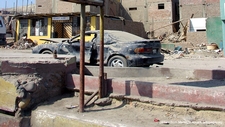Earthquakes
Supporting

TEKS Objective
The student is expected to investigate rapid changes in Earth's surface such as volcanic eruptions, earthquakes, and landslides.
Essential Understanding
The students know that Earth consists of useful resources and its surface is constantly changing.
Science Background
Earthquakes: US Geological Survey (website) – Everything you ever wanted to know about earthquakes.
Earthquakes
by Kaye M. Shedlock & Louis C. Pakiser, US Geological Survey, pubs.usgs.gov
Signature Lesson
Earthquakes: Utah Education Network (website) - Students investigate the five ways that Earth's crust changes rapidly along a fault.
- Supporting Lessons
- Extensions
- Assessment Ideas
- Literature Connections
- Related
TEKS - Additional Resources
Supporting Lessons
Earthquakes and Volcanos: National Geographic Xpeditions (website) - Students compare plate tectonics maps with population density maps, and investigate what these maps indicate about the relationship between population and seismic hazards.
Earthquakes and Volcanos
National Geographic Xpeditions, www.nationalgeographic.com/xpeditions
Peanut Butter and Jelly Sandwich Faults: US Geological Survey (PDF) - This activity uses bread, jelly and peanut butter (substitute another spread if concerned about peanut allergies) to teach students about different types of faults.
Peanut Butter and Jelly Sandwich Faults
US Geological Survey, earthquake.usgs.gov
How to Make an Earthquake Model for Kids: eHow.com (website) - Build a fun, easy—and edible—earthquake model out of gelatin.
How to Make an Earthquake Model for Kids
by Carrie Perles, eHow.com
Elaboration Lessons and Extensions
Geological Processes: Utah Education Network (website) - This activity is designed as a game board that deepens students’ understanding of the effects of weathering, erosion, uplift, sudden changes, earthquakes and volcanoes on the geological features of Earth.
Geological Processes
Utah Education Network, www.uen.org
Earthquakes: Exploring Earth (website) - Interactive website with background information, animations, games, investigations, data, and local resources.
Earthquakes
Exploring Earth, Houghton Mifflin Harcourt Publishing Company, www.classzone.com
Assessment Ideas
Have students draw examples of each of the five plate interactions. Using their journal notes, students should add a minimum of three sentences to describe each of their five illustrations.
Literature Connections
Jump Into Science: Earthquakes. Prager, Ellen (ISBN-10: 1426300905)
Earthquake in the Early Morning. Osborne, Mary Pope (ISBN-10: 067989070X)
Pandas’ Earthquake Escape. Perry, Phyllis (ISBN-10: 1607180715)
Volcano and Earthquake. Van Rose, Susanna (ISBN-10: 0756637805)
Earthquakes and Other Natural Disasters. Griffey, Harriet (ISBN-10: 0756659329)
Additional Resources
Understanding Earthquakes, Learning from Kobe: National Geographic (website) - A case study of the 1995 earthquake in Kobe, Japan, helps students to understand earthquakes.
Understanding Earthquakes, Learning from Kobe
National Geographic, www.nationalgeographic.com
Earthquake Hazards Program: US Geological Survey (website) - Teacher resources, photo collections and interactive maps on earthquakes. (HAPG Resource)
Earthquake Hazards Program
US Geological Survey, earthquake.usgs.go
Faultline: Exploratorium (website) - Comprehensive website that looks at earthquakes in a historic perspective as well as a scientific one.
TEKS Navigation
Grade 3
Need Assistance?
If you need help or have a question please use the links below to help resolve your problem.

Comments